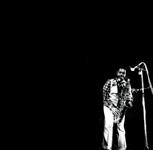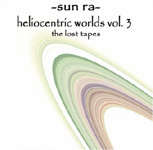 Dropping Acid And Speaking Esperanto, Man! : The Return Of ESP-Disk Dropping Acid And Speaking Esperanto, Man! : The Return Of ESP-Disk
by Matthew Sumera
18 April 2005
The story of ESP-Disk need not be reiterated here at length. Anyone who owns a recording from ESP’s glory days will be well familiar with this history already, or can easily read about it on most ESP-Disks, whether in their current or previous incarnations. It is an interesting story, indeed, the story of an entrepreneurial man, Bernard Stollman, who was at the right place at the right time. Fans of free jazz certainly owe much to Stollman and ESP-Disk for documenting some revolutionary sessions during a period when few others could or would. And for this, we are indebted. But there has always been an ambivalent relationship between fans and supporters of free jazz (and those who make the music) and the label that came to be known as ESP-Disk. Whether stemming from allegations of shady and unfair business practices—as Val Wilmer writes in As Serious As Your Life, “Stollman became simultaneously the most hated and most needed man in the recording industry”—or the very nature of ESP’s always self-serving approach to the marketing and packaging of the music—the obligatory and conspicuous tagline (“The Artists Alone Decide...”) that graces the CD spines of the newest re-releases should make one pause—ESP-Disk recordings have always been marred by a slapdash, half-baked delivery that more than reeks of hagiography, primitivist fascination, and hippie-dippie-(freeeeeeeeeeee)dom. Unfortunately the newest batch of re-releases from ESP-Disk doesn’t clear up this ambivalence. Admittedly these are stunningly important sets of mid-60s “new music”, including the Albert Ayler Trio’s seminal Spiritual Unity, Ayler’s Live on the Riviera, Sun Ra’s Heliocentric Worlds, Vol I, II, and III (the last purportedly to be “Lost Tapes”), and Pharoah Sanders’ Pharoah’s First. The overall presentation and repackaging, however, has a net-diminishing effect, plunging these recordings into the mire of personal, uninformative recollections, patchouli-scented free-bop prosody, and in one notable case, second (perhaps even third or fourth) generation recording sources. Instead of treating the albums with the dignity and respect they deserve, this remastered series comes off as a rush job, one patently calculated to fill ESP-Disk coffers.  These are obviously serious allegations, so it would be worthwhile to dig into the individual albums to pull out choice quotes in support. Perhaps the most conspicuous and galling packaging of damaged doggerel comes from the pen of “The Good Doctor Bop”, whose liner notes to Pharoah’s First are particularly vapid. Writes the Doc, “One day on a magical TRIP, I heard the essence of what was really the objective of the Free Music of the 60’s. It took the activity of a tab to bring everything into clarity for me.” That the Good Doc’s monolithic understanding of all 1960s Free Music—after all, didn’t it all just sound the same anyway?—only came about through the aid of a hit says little about the music and its political, cultural, or aesthetic significance but a lot about the failures of the Doc as, in his words, a “Jazz music historian”. That the Good Doc didn’t dig the music at first is fine. That he finally understood it with penetrating, all-encompassing, crystalline clarity only after dropping is fine. That he should be the one writing the liner notes to a recording as important as Pharoah’s First, and that he should dwell on such episodes in the notes, is suspect. These are obviously serious allegations, so it would be worthwhile to dig into the individual albums to pull out choice quotes in support. Perhaps the most conspicuous and galling packaging of damaged doggerel comes from the pen of “The Good Doctor Bop”, whose liner notes to Pharoah’s First are particularly vapid. Writes the Doc, “One day on a magical TRIP, I heard the essence of what was really the objective of the Free Music of the 60’s. It took the activity of a tab to bring everything into clarity for me.” That the Good Doc’s monolithic understanding of all 1960s Free Music—after all, didn’t it all just sound the same anyway?—only came about through the aid of a hit says little about the music and its political, cultural, or aesthetic significance but a lot about the failures of the Doc as, in his words, a “Jazz music historian”. That the Good Doc didn’t dig the music at first is fine. That he finally understood it with penetrating, all-encompassing, crystalline clarity only after dropping is fine. That he should be the one writing the liner notes to a recording as important as Pharoah’s First, and that he should dwell on such episodes in the notes, is suspect.
Unfortunately the insipidness doesn’t end there, and by the conclusion of his essay, the Doc admits that he really hasn’t even paid attention to the current status of Sanders and his work: “At the time of this writing (12-27-04), Pharoah Sanders is still with us. I haven’t heard much about him lately, and hope he is in the best of health and is still keeping the fire alive.” For the Good Doc, it appears, it is not the responsibility of a liner note writer to do even the least bit of research to present a compelling, thoughtful, educational, and even entertaining analysis of a recording and its scope within the overall output of a particular artist. Clearly in the minds of ESP-Disk executives, consumers are far more interested in the Doc’s extrasensory perceptions and personal biography than the role of Pharoah’s First within Sanders’ now four-decade long career. And lest one argue that the Good Doc does indeed talk about Sanders’ career within even remotely useful contexts, I offer you the following quote: “The double album Journey to the One sparked a frenzy of interest in Pharoah as a true artist... he was in top form and taking no prisoners. The song You Gotta Have Freedom was on the lips of everyone at the time.” It’s comforting to know that the Good Doc can discern artistic authenticity from fraudulent wanking. Aesthetically indolent and filled with clichés, the Doc appears to live in a world were the average person on the street walks around humming Pharoah Sanders’ tunes. Perhaps that fateful TRIP hasn’t yet come to an end.  While readers may suggest that these criticisms are overly harsh, they are so because the import of these sessions cannot be undervalued. It bears repeating: ESP-Disk recorded some of the most influential free music of the mid-to-late 1960s. Their vault is filled with gems of new music, making their cavalier attitude to re-releasing, packaging, and commodifying these recordings all the more reprehensible. Where care, concern, research, and solid writing should have reigned, consumers, academics, musicians, and historians are presented with platitudes like the ones above. Another example, this time uncredited, from Heliocentric Worlds Vol. 3: “Deterioration of a portion of the tape required the deletion of about one minute of music, but you won’t notice it.” Translation: “All this shit sounds the same anyway, so don’t worry. It hardly matters.” Can one imagine the same approach being taken to the release of a “lost” Glenn Gould recording? While readers may suggest that these criticisms are overly harsh, they are so because the import of these sessions cannot be undervalued. It bears repeating: ESP-Disk recorded some of the most influential free music of the mid-to-late 1960s. Their vault is filled with gems of new music, making their cavalier attitude to re-releasing, packaging, and commodifying these recordings all the more reprehensible. Where care, concern, research, and solid writing should have reigned, consumers, academics, musicians, and historians are presented with platitudes like the ones above. Another example, this time uncredited, from Heliocentric Worlds Vol. 3: “Deterioration of a portion of the tape required the deletion of about one minute of music, but you won’t notice it.” Translation: “All this shit sounds the same anyway, so don’t worry. It hardly matters.” Can one imagine the same approach being taken to the release of a “lost” Glenn Gould recording?
It is utterly mystifying how ESP-Disk has chosen to relaunch their label with such useless and indecorous material. And if the liner notes and packaging weren’t bad enough, the “remastering”, especially in regards to Sun Ra’s Heliocentric Worlds I and II, is downright atrocious. Sourced from a second, if not third, generation recording, it sounds like mud—crackly, aging sludge. To release the recording that most solidified Sun Ra’s career and legacy in Europe in this fashion is truly reprehensible. Surely someone could have done a better job of securing a better sound (and source) for the recording; my vinyl copy licensed by ZYX and released by Get Back Records, for example, sounds worlds better. There are a few aspects of the remastered discs that do deserve kudos, among them being a significantly boosted sound for Gary Peacock’s bass on Spiritual Unity. His key contribution to the set can be heard for the first time clearly. In addition, Steve Tintweiss pens some moving liner notes to the 25 July 1970 set at the Maeght Foundation, including intriguing insight into the concert and Ayler’s preparation: “‘You just start with the bow, then I’ll come in and we’ll go from there’, instructed the leader to Allen Blairman and myself.” Ultimately the ESP-Disk recordings are all worth owning for their musical value alone—although seeking out a different version of Heliocentric Worlds I and II is highly recommended. In addition, the solvency of the label is clearly important to ensuring that these recordings stay around for decades to come. In the age of the reissue, though, there are solid models for how to provide added value while still respecting the music and musicians and ensuring the ever-important bottom line. High-profile leaders such as Mosaic and Blue Note’s RVG series, or even the less polished but still spectacular work of JSP and the remastering by John RT Davies, represent a diverse approach to the art of the reissue. Providing solid historical information, added tracks where appropriate, and additional session photos if available, reissues can help provide additional information to the collector and much needed context to the novice approaching the music for the first time. ESP-Disk has decided to go its own way. (Check out those liner notes to Spiritual Unity. “The title says it all ‘ESP-DISK’.” This isn’t the story of the session; this is the story of the label. And for that, they’ve clearly missed the boat.) Perhaps this shouldn’t be a surprise, given ESP-Disk’s history, but one could have hoped for more. Undoubtedly “The Artists Alone Decide...”, but surely none of them benefit from such a slipshod affair.
|

